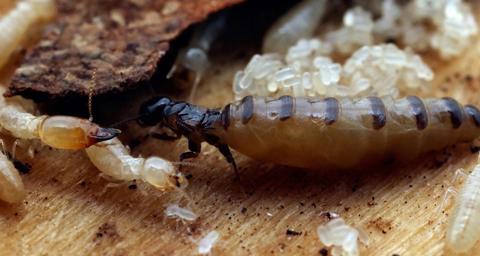Common Types of Termites in Singapore
Termites are social insects that live in colonies underground and mainly eat cellulose, a substance found in wood. Many people think termites live in wood, but they actually live in the soil. The big problem is that termites can cause serious damage to buildings, and since they hide deep inside the wood, it can take a long time to notice there's a problem.
- Subterranean Termites : These termites live underground and build mud tubes to reach wood above the ground. They are the most common and cause the most damage to homes.
- Drywood Termites: These termites live inside the wood they eat. They don’t need soil or much moisture, so they can damage things like furniture, doors, and walls.
- Dampwood Termites: These termites like wet or rotting wood. They are often found in places with high moisture, like near leaky pipes or in damp areas.
Termite Colonies Have Different Roles
A termite colony has different types of termites called castes. Each caste looks different and has a special job to do. The main jobs are finding food, protecting the colony, and reproducing. There are three castes:
- Workers
- Soldiers
- Reproductives (the king and queen)
Most Termites Are Not Harmful
There are over 3,000 species of termites in the world. Less than 6% are pests that damage wood and buildings. Most termites are actually important for the environment. They help break down dead plants and return nutrients to the soil.
Termite Lifespan by Caste:
- Worker termites: they live 1 to 2 years
They perform labor tasks like building tunnels, foraging, and feeding others. - Soldier termites: they live 1 to 2 years
They defend the colony and are also fed by workers. - Reproductive termites (Kings and Queens):
Kings: Typically live up to 10 years.
Queens: Can live 10 to 30+ years, depending on the species — they have the longest lifespan in the colony. - Alates (winged swarmers):
These are future kings and queens. Once they leave the colony, find mates, and start new colonies, they either become long-lived royals or die within days if unsuccessful.
facts:
- Subterranean termite queens (like Reticulitermes spp.) can live 15–25 years.
- Drywood termite queens tend to have shorter lifespans.
- Environmental factors (predators, temperature, pesticides) can reduce these lifespans dramatically.
Damage Caused by Termite Infestation
In Singapore, termite infestations are quite common due to the warm and humid climate. Termites feed on materials that contain cellulose, like wood. They can damage both new and old wood, and may also chew through materials like plasterboard or drywall.
Subterranean termites, the most common type in Singapore, build their nests underground and can enter homes through tiny cracks in walls or flooring. If left untreated, they can cause serious structural damage and even lead to parts of the building becoming unsafe.
Because termite damage often goes unnoticed until it’s severe, it’s important to act fast. If you see signs like mud tubes, hollow-sounding wood, or discarded wings, you should contact a licensed termite control company in Singapore immediately for inspection and treatment.
Signs of Termite Infestation
- Mud Tubes: Thin, muddy tunnels on walls, beams, or foundation. Built by subterranean termites to travel safely and stay moist.
- Hollow-Sounding Wood: Tap wooden surfaces — if it sounds hollow, termites may have eaten it from the inside.
- Blistered or Bubbling Paint: Looks like water damage but could be caused by termites tunneling beneath.
- Frass (Termite Droppings): Small, sand-like droppings (usually from drywood termites) found near walls or furniture.
- Discarded Wings: Found near windowsills, doors, or lights.
- Winged termites (alates) shed their wings after swarming to start new colonies.
- Tight-Fitting Doors or Windows: Wood may swell or warp due to termite activity, making it hard to open or close.
- Clicking or Tapping Sounds: Soldiers bang their heads or shake to signal danger, which may sound like faint clicking inside walls.
Perform checks every 3–6 months, especially during hot and rainy seasons when termites are more active in Singapore.
Do you need an estimate for service or have questions about pests?
We'd love to hear from you! Complete the form below and one of our experts will get back to you as soon as possible.
Read more about Termite Control.
